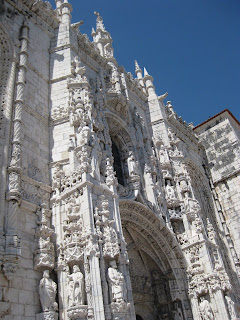The bus from Lagos to Lisbon travelled through a lot of territory that looked exactly like the West Australian wheat-belt, substituting olive trees for gums. In some places you didn’t even have to substitute – stands of tall eucalypts dotted the dry grassy plains and the only unfamiliar sights were the ruins of old villas. That all changed whenever we crossed a river valley; it seemed as though every square metre of the deep fertile soil was planted with vegetables, citrus trees, apricots, figs, sweetcorn, tomatoes … with the typical Mediterranean white walled, terracotta-roofed villages skirting the fields.
The outer suburbs of Lisbon are dominated by residential blocks, hundreds of them side by side, all designed and built with brutal economy, I guess during the Salazaar dictatorship in the 60s and 70s. It was a pretty depressing sight after the charm of the villages, and the layers of graffiti over everything didn’t improve the aesthetics, though it might have provided some residents with an outlet for expressing how they felt about the place.
And then, there is the city proper. Built on a series of hills, there are grand views everywhere. Castles, monasteries, churches and forts sit side by side with beautiful modern buildings and wonderful public gardens. The whole city is paved in cobbles of polished white limestone and black basalt, often in quite intricate designs. The broad River Tagus and the Tejo run alongside, recalling the days when Portugal was the world’s foremost seafaring and trading nation. The best place to get a sense of the Age of Discovery is in the old district of Belem, where you can see Vasco da Gama’s tomb in the extraordinarily ornate Mosteiro dos Jeronimos, and, alongside, a wonderful maritime museum.
The artefacts here really are awe-inspiring – the actual instruments, charts, weapons and everyday objects used by the great sailors of the fifteenth and sixteenth centuries. The museum has the best models I’ve ever seen – absolutely exquisite scale models of ships, made from authentic materials and perfect down to the last tiny wooden block and miniscule knot.
Also preserved in the museum are the Portuguese royal vessels through the ages, including a couple of sixteenth century royal barges. These must have been something to see afloat, with twenty powerful oarsmen on each side, silk and velvet canopies, and a gilded dragon figurehead.
Belem is also famous for these delicious little egg custard tarts called pastel de nata, made from a secret recipe in the monastery. I didn’t think it was possible to find something better than Chinese dan ta, but these might just have the edge. The line at the monastery bakery wound way down the street so we had to compromise and go to a nearby cafe to eat slightly inferior pasteis de nata.

There's a lot more Lisbon stuff to come, so I'll just post this bit for now while I sort through all the photos and memories - see you soon!


No comments:
Post a Comment